Australian gun law: Inside John Howard’s battle to rid guns from Australia
Australia’s gun laws are internationally recognised and one of John Howards’ crowning achievements but the road to get there was filled with opposition.
When it comes to Australia’s internationally lauded gun laws, the image of John Howard addressing a pro-gun rally in the regional Victorian town of Sale might be a lesserknown chapter to our country’s fight for gun reform.
On April 28, 1996, just six weeks into Mr Howard’s first term as prime minister, Australia was rocked by the Port Arthur massacre. The horrific attack saw 28-year-old, Martin Bryant kill 35 people in a deadly shooting spree.
Stream more Australian news with Flash. 25+ news channels in 1 place. New to Flash? Try 1 month free. Offer ends 31 October, 2022 >
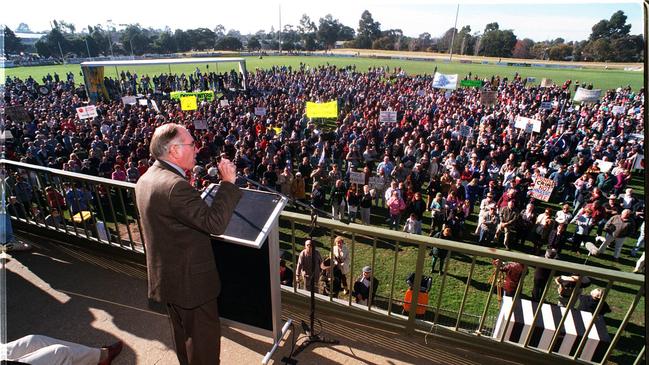
His guns – a semiautomatic AR-15 rifle and a L1A1 Self-Loading Rifle battle rifle – were purchased legally. At one point Bryant killed 12 people in 15 seconds. The heinous act happened at the Broad Arrow Cafe where tourists waited for the ferry.
However, while the Port Arthur massacre saw Mr Howard prioritise gun reform, the road to change was met with opposition, scepticism and criticism from a small but vocal minority.
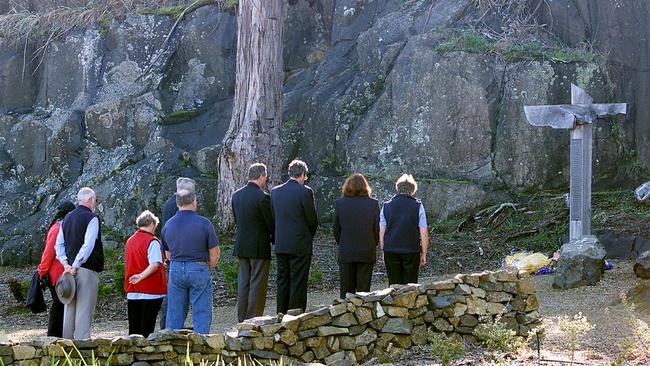
A vocal minority
Convener Australian Gun Safety Alliance, Stephen Bendle said the move for stricter firearm control was “very unpopular” in some circles, especially among rural and regional farmers and recreational shooters.
“It is only a minority who had a personal interest in maintaining gun laws,” he said, speaking to news.com.au.
“It was mainly among recreation shooters and farmers. It was a relatively small number of people had firearms but they were vocal and they were certainly vocal at the time.”
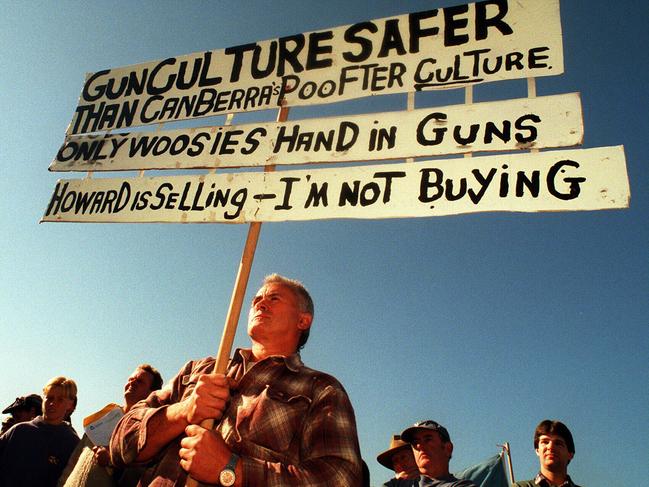
Speaking to The Guardian, gun control advocate Rebecca Peters said that campaigning for reforms led to her receiving death threats, rape taunts and a brick thrown through the window of her Sydney home.
Recalling a voicemail she received at the time, it said: “You wouldn’t know a gun if I put my .303 up your c**t and pulled the trigger.”
“It’s hard to communicate how scary it was,” she said.

Mr Howard wearing a bulletproof vest under his suit would also go on to symbolise the tensions between those opting for gun reform and impassioned gun owners.
Although Mr Howard now regards it as one of the biggest regrets from his time as Prime Minister, his security believed a threat had been made on the Prime Minister’s life.
“I should never have worn it,” he told 9News.
“That was security advice I was given. I never really felt unsafe in Australia.”

Gun reform 10 years in the making
Although the events at Port Arthur leveraged a national response to gun reform, Mr Bendle said the push for greater gun control had already been brewing in the political agenda.
“Between 1987 and 1996, there were 29 national meetings between police ministers and gun reform was on the agenda on 20 of those meetings,” he said.
“It had been a conversation among place have been a conversation among government for many, many years but there were some holdouts.”
“It had been a 10-year conversation.”
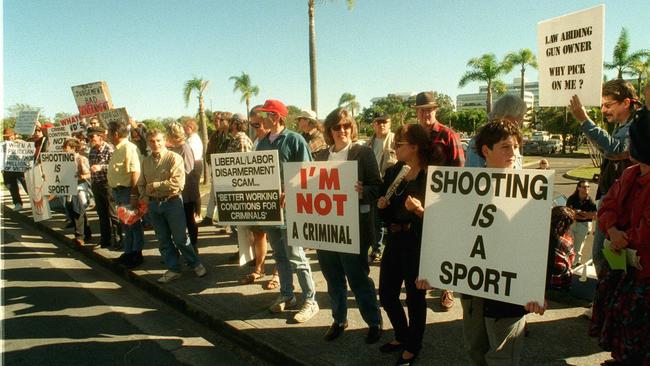
Due to Australia’s Federation, gun laws existed as a state issue, with regulations in Tasmania and Queensland the most lax.
This meant that while reform could be attempted by an individual state or territory, or on a commonwealth level, certain states would vote against such legislation.
For example, in 1987 then Prime Minister Bob Hawke made a bid to state premiers to implement national laws at a firearm summit. This was after Victoria’s 1987 Hoddle Street and Queen Street massacres which saw seven and eight victims die respectively, and a combined 24 people injured.
However, Mr Hawkes attempt failed, largely due to the lack of support from Queensland and Tasmania.
At the time, an inflamed NSW Premier Barrie Unsworth said: “It will take a massacre in Tasmania before we get gun law reform in Australia.”
Mr Unsworth would go on to regret his statement, with the tragic prophecy unfortunately coming true.
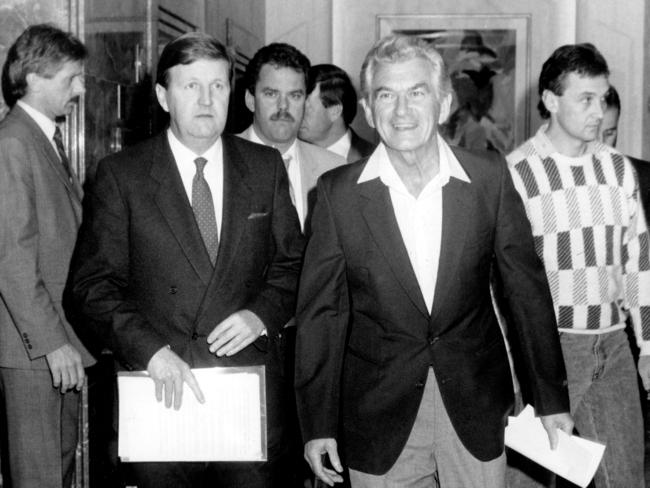
Port Arthur Massacre forces action
In less than two months after Bryant took the lives of 35 people, the Howard government began implementing tougher restrictions on gun ownership.
The non-binding National Firearms Agreement was adopted on May 10, 1996 between the Commonwealth, as well as all states and territories. This included a ban on all automatic and semiautomatic weapons, bar a small number of licensed permit holders.
Processes around obtaining a gun license were also strengthened, a national firearm registry was created, in addition to strict controls around firearm ownership.
For example, the firearm and ammunition must be stored separately and both in a locked safe. Depending on the state and territory, there are also weight and material requirements related to the storage.
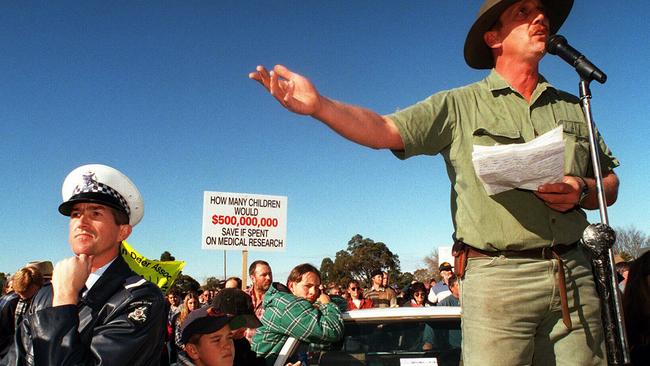
Another large part of the plan was the $500 million National Firearms Buyback Program. Held between October 1996 to September 1997, 650,000 guns were returned and destroyed by the government. In order to fund the program, the government increased the Medicare levy from 1.5 to 1.7 per cent.
“It took Port Arthur to create the burning bridge for governments to act,” said Mr Bendle.
“The bipartisanship support among Labor, Liberal and even the Nationals party also helped to push the legislation through parliament.”
Still, the policy wasn’t without its dissenters. In Sydney on June 2, 1996, 60,000 gun owners staged one of the biggest protests since the Vietnam War.
The leader of the Nationals party Tim Fischer also faced political pressure among party members and regional Australians for his commitment to gun reform too. Speaking to The Guardian in 2016, he said people told him his support of the agreement world cost him his seat.
However, upon Mr Fischer’s death in 2019, former Nationals leader Michael McCormack applauded his conviction and dedication.
“There are people alive today who wouldn’t be if not for Tim Fischer and the courage he showed for all Australians,” he said. “Tim was a giant, a man of courage.

Speaking to The Australian, Mr Howard said his support for reform was “instinctive”. It would also go on to be one of the most celebrated moments of his prime ministership.
“When I learnt what had happened, and I had absorbed the magnitude of the slaughter, I thought well heavens above, you’ve got this huge majority,” he said.
“If you don’t use it to do something to bring about a change, well you’ve failed the first test.”
From 1997 to now
Since Australia’s firearm buyback ended in September 1997, there has only been one incident which saw gun violence lead to a mass-shooting of over five people. This occurred in 2018, when a grandfather in Osmington, Western Australia killed his four grandchildren, his daughter, wife and then himself at their family home.
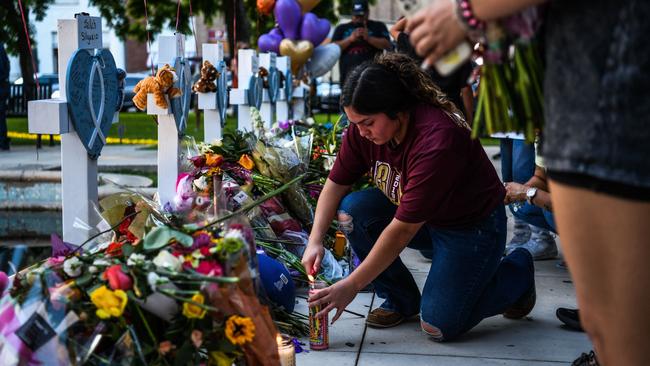
While gun violence should not have a passing minimum, the figures in the United States paint an even bleaker picture.
In 2021, more than 45,000 lives were lost to gun violence, be it through homicide, murder, suicide, accidental or defensive gun use, the Gun Violence Archive reports. In that single year there were 692 injuries and deaths attributed to mass shootings.
This week’s tragic school shooting, which occurred in the small southern Texas town of Uvalde was the 27th school shooting to happen in 2022 alone.
The latest reliable data - figures from Swiss-based research project Small Arms Survey - estimated that there were 390 million guns in circulation in America in 2018.
That means there are more guns than people in the US.
Americans respond to Aussie gun laws
America’s liberal gun laws – heavily backed by the NRA and many politicians – still remain popular among a large part of the population.
Even when confronted with what other nations have done, like Australia’s successful amnesty of 650,000 guns after the 1996 Port Arthur Massacre, many Americans appear to be quite happy with the way things are.
On an article about what Americans can learn from Australia, many from the US in the comments suggested the Aussie approach wasn’t viable for their country.“There are few ways to interpret the data Australia published after the ‘gun confiscation’, although there are still guns in the public hands in Australia, don’t be fooled,” one person said. “Australia is not the United States. What the United States needs is mental health care for people in need, not authoritarian arms confiscation.”
“America is not Australia,” said another. “The gun culture here is very deeply rooted in American culture.”
“America has over 360 million (guns), and that’s only what we know of,” added a third. “You’re also talking about a major world power here (the US). No one wants to invade Australia. If anyone invades America, not only will you face the strongest military in the world, you will have a very hard time with America’s own citizens.”
“Wait for an enemy invasion from another country and get back to me after your experience,” said another.
However, many other Americans suggested their country could learn a lot from Australia.
“The main takeaway is: They do it better. EVERYONE ELSE does it better,” said one. “We are, as poet Amanda Gorman wrote, “One nation, under guns.” And we are an absolute joke and failure on this front.”
“We like our guns more than we care about strangers’ children. It’s that simple and it’s the quiet part we rarely say out loud,” added another.
“Unfortunately most Americans have accepted this is who we are,” added another. “We are a society of guns. We will always have guns. So because of that we have to accept that mass shootings are who we are as well. As long as there are guns there will always be mass shootings.”



